Review: Amazon Fire Phone for AT&T
Menus
FireOS is best shown, not told. That's why I created this video for you to watch. It covers all the basics of how the user interface works, including its quirks and qualities. I will, however, attempt to describe it here.
FireOS is based on Android, but not how you've ever seen it before. Amazon created its own version of Android, complete with its own user interface, apps, menus, and settings. Google-made apps, such as Gmail, Maps, and Calendar, are nowhere in sight.
The lock screen offers only the most basic information, which includes the time, and the number of new emails, messages, or calls since last checked, which appear near the top. The clock is often hidden in part of the animated lock screen, and it takes a second to locate. This can be a bit of a hassle. The notifications are so small that I often couldn't tell how many new emails I had unless I brought the phone right up to my eyeballs. There are no shortcuts to the camera or other apps. You can add a password or lock if you want to.
The main home screen consists of a carousel with either your most recently-used or favorite apps. Each app has a dynamic list of stuff underneath it as you scroll back and forth through the carousel. For example, your three most-recent emails or messages appear underneath the email and messaging app icons, respectively, when viewed on the home screen carousel. The carousel items can be adjusted and reordered, but they appear on a dismal gray background that I found depressing (and unchangeable).
There are four icons that appear in a dock below the carousel (phone, messages, email, browser). These are constant. If you grab them and swipe upward you'll reveal the entire app tray. The Fire Phone has a limited number of preinstalled apps because there aren't that many apps for the platform yet. The smartphone basics are here (calendar, maps, clock, gallery, and so on). The apps in the app drawer can be rearranged and added to folders if you want. Press-and-hold to mark any given app for inclusion on the home screen.
The settings tools are really straight-forward, and I like them. The settings are lumped into categories that are spelled out in plain language: Connect to Wi-Fi, See Your Cellular Data Usage, and so on. It really helps speed up customizing the phone and setting it up. Speaking of customization, the phone lets you adjust all the normal stuff, such as ringtones, lockscreen wallpapers, screen brightness, volumes, parental controls, passwords, etc.
If this were the sum of the user interface, I'd call it boring but functional. There's much, much more.
There's a whole bunch of gestures that bring up secondary details to almost every screen and every app. I detailed how the gestures work here. The three basics are snapping the left edge toward you, snapping the right edge toward you, and rotating the top edge downward.
Perhaps the best way to imagine it is to think that every possible screen on the phone is flanked by two off-screen panels. Tilt the right edge toward you to bring the right panel onto the screen, tilt the right edge away from you to send it back. Same for the left side. Rotating the top of the phone toward you brings down a control panel from the top, which provides quick access to radios, brightness, and other similar tools.
To complicate things further, these gestures are all duplicated by swiping on the screen - which I often found to be faster, but not necessarily more reliable. Even worse, after you've tilted one of the panels onto the screen, even more information shows up if you angle the screen further. This info is contextual, such as how many songs are in your music library, but is often hard to read since you're viewing the screen at a pitched angle. It's like ephemeral, ghost info, and you're being dared to read it.
It's a bit of a mess, and far more complicated than it needs to be to present information to Fire Phone owners. I'll give Amazon points for some unique ideas here, but the user interface is not my cup of tea. I prefer the more straight-forward approach taken by Android, iOS, and Windows Phone.
As far as performance goes, I didn't see any problems with the apps, menus, or any part of the system. The Fire Phone runs fine.
Dynamic Perspective
Amazon's Dynamic Perspective idea compounds all the user interface issues. Dynamic Perspective employs the four user-facing sensors on the front of the phone to determine the location of your face and direction of gaze in relation to the screen. It uses this data to generate a 3D look and feel to many elements of the Fire Phone's UI and screens. All the lockscreens, for example, are 3D in their appearance. You can tilt the phone to peer around corners, see past clouds, and discover other animated treasures that are just off-screen when viewed head on. There are several games that ship with the Fire Phone that make good use of Dynamic Perspective. (I like the one with the monkey.)
But Dynamic Perspective is sprinkled throughout the UI. For example, the carousel and app drawer have icons that move and rotate as you tilt the phone. It's most visible on the home screens, and is thankfully absent from many of the apps themselves. It may give some people motion sickness. If you don't like it, the Fire Phone allows users to turn off Dynamic Perspective as a whole, or individual features like tilt, swivel, or peak.
Calls and Contacts
The basic communication apps will feel familiar to most anyone who's used a smartphone in the past. The phone's default screen is whichever one you used last, be that the call log, favorites, dialpad, or voicemail. These are all accessible via tabs at the bottom of the screen. The dialer works as expected. In-call tools include send-to-speaker, mute, open diapad, and add a line. There's no way to send a call to Bluetooth after it is connected. The phone also allows you to forward incoming calls and reply with text messages.
The contact application strongly resembles those of most Android devices. Contacts are displayed in a clean format with attractive drop-shadows. A quick tap of the person's photo brings up their basic contact details, including phone number and shortcut for messaging. You have to press the contact's name to open the full contact card, which contains tons of data and is a snap edit or share.
Messaging
The Fire Phone's text messaging application is clearly built on the foundation laid by Google's text messaging app. It's cleaner looking and has a nice color palette, but the functionality is the same. Messages are laid out in threads with different colored bubbles separating your text from that of your friends. It is quite easy to add pictures or video to messages.
The Fire Phone's keyboard works very well. It supports trace input, so you can drag your finger from letter to letter rather than type out each word if you want. The prediction engine is very good, and often offered perfect suggestions for the next word. It can also handle voice dictation and I found accuracy to be excellent.
The email application supports most types of email accounts, including POP, IMAP, and Exchange. The user interface is spartan, but the clean design is appealing in its own way. Amazon covered the basics, which means you can delete, respond to, or archive messages, as well as move, flag, and label them. Email conversations appear threaded, and images appear quickly. The settings allow you to turn off email threading, block image downloads, and tweak notifications. It's not a bad app and compares favorably to the iOS email app. It falls short of Gmail as experienced on Android devices.
There are no social networking apps preloaded, nor is there any sort of instant messaging client. I was able to find Facebook and Twitter in the Amazon Appstore. I was able to find WhatsApp, but not SnapChat. The Fire can run many Android apps, but not all.


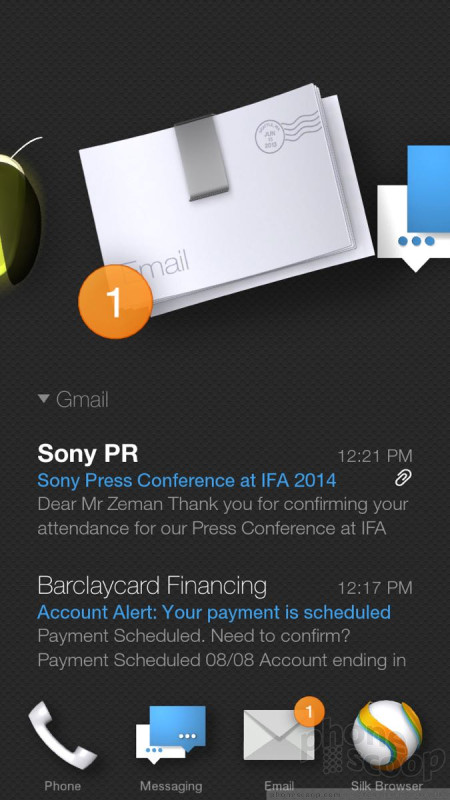


















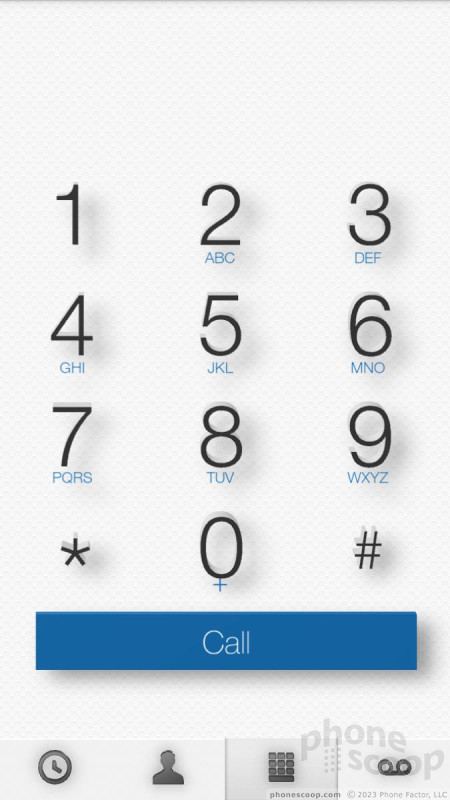




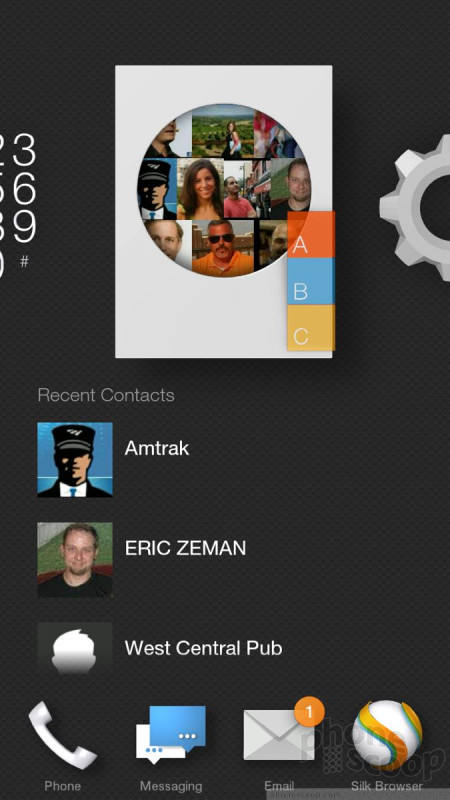






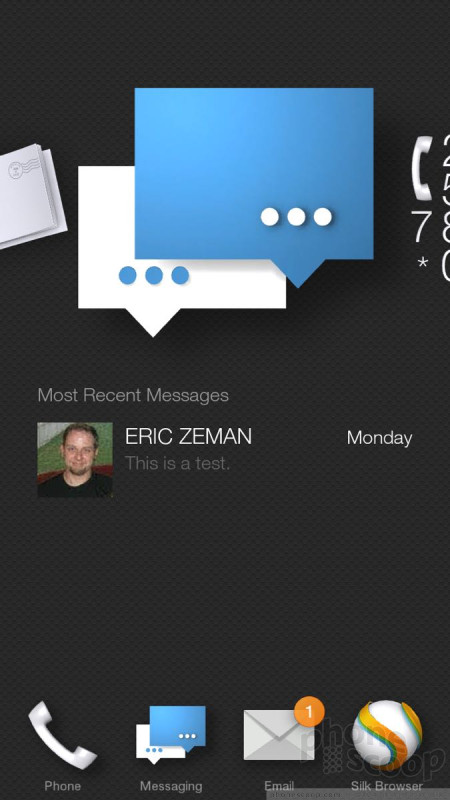









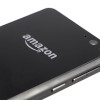 Video Tour: Amazon Fire Phone
Video Tour: Amazon Fire Phone
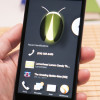 Hands On with Amazon's Fire Phone for AT&T
Hands On with Amazon's Fire Phone for AT&T
 Liveblog: Amazon's New Mobile Play
Liveblog: Amazon's New Mobile Play
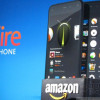 Amazon Intros Fire Phone
Amazon Intros Fire Phone
 Amazon Brings Prime Music to Smartphones
Amazon Brings Prime Music to Smartphones
 Amazon Fire
Amazon Fire



